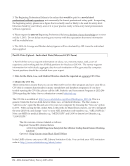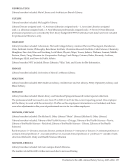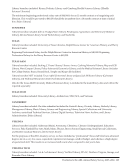12 · ARL Annual Salary Survey 2013–2014 Figure 3d: Distribution of Professional Staff in All ARL University Libraries by Sex, FY 2013–2014 Combined Men Women Total Number of Staff Percent of Staff Number of Staff Percent of Staff Staff Main 3,211 37.8% 5,289 62.2% 8,500 Medical 219 24.1% 688 75.9% 907 Law 265 34.8% 496 65.2% 761 All 3,695 36.3% 6,473 63.7% 10,168 ARL recognizes the difficulties that the profession has in attracting a diverse workforce and continues to work actively in the development of workplace climates that embrace diversity. One way that ARL achieves this end is through the work of the ARL Diversity Program. The ARL Diversity Program through its Leadership and Career Development Program and the Initiative to Recruit a Diverse Workforce, emphasizes ARL’s and its members’ commitment to creating a diverse academic and research library community to better meet the new challenges of global competition and changing demographics. Further, the diversity program focuses on issues surrounding work relationships in libraries while considering the impact of diversity on library services, interactions with library users, and the development of collections. More information about the diversity program can be found at http://www.arl.org/leadership-recruitment/diversity-recruitment. ClimateQUAL® is an assessment initiative that focuses on some of the same issues. It is the statistics and assessment program’s tool that assesses organizational climate and diversity in libraries. ClimateQUAL helps libraries plumb the dimensions of climate and organizational culture important for a healthy organization in a library setting. The survey addresses climate issues such as diversity, teamwork, learning, and fairness, as well as current managerial practices, and staff attitudes and beliefs. Libraries use their survey data to improve their organizational climate and diversity culture for delivering superior services to the communities they serve. More information about ClimateQUAL can be found at http://www.climatequal.org. Gender data Many readers of previous surveys have inquired about evidence of gender-based salary differentials in ARL libraries. Additionally, data on salary comparisons for directors are frequently requested. In 2008–2009 and 2009– 2010, the average salary for female directors was slightly higher than that of their male counterparts. For the past three years, the trend was reversed. For the first time since 2009–2010, the average salary for female directors was slightly higher than that of their male counterparts (see Table 18). In keeping with previous years, the 2013–2014 data show that salaries for women in US ARL university libraries have not yet met parity with that of men (see Table 18). In 2013–2014 the overall salary for women was 96.3% of that of men for the 115 ARL university libraries (compared to 96.22% in 2011–2012). This suggests a slow, long- term trend towards closure of the gender gap in ARL libraries — in 1980–81, women in ARL libraries made roughly 87% that of men. Table 18 displays 19 job categories females earn more than their male counterparts in just 6 of the 19 categories listed. Table 20 provides average years of professional experience for many of the same staffing categories for which salary data are shown in Table 18, revealing that experience differentials may explain some differences within specific job categories. Women have more experience in all but one of the six job categories in which they










































































































































































